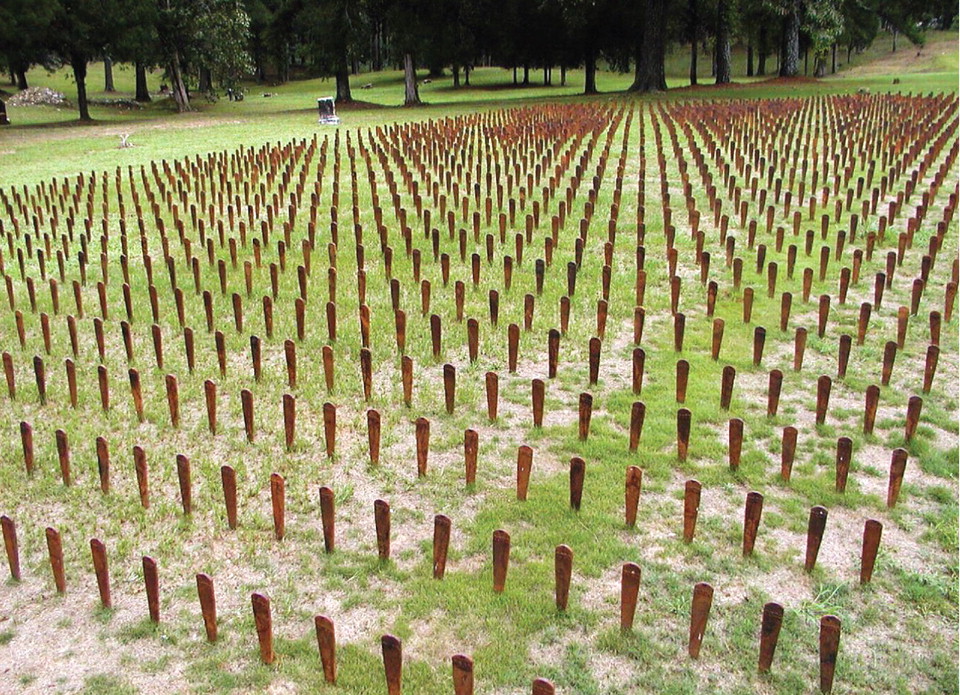They Died With No Fanfare, But That May Change
Across the United States, the graves of tens of thousands of people who once lived in state mental hospitals lie almost forgotten.
In Oregon, 5,000 copper urns hold the cremated remains of patients who died at Oregon State Hospital in Salem. Perhaps 25,000 patients lie buried at the former Georgia State Lunatic Asylum in Milledgeville, their graves indicated only by small, rusted iron markers. Groundskeepers in the 1960s uprooted even those tokens to make mowing the lawn easier.
“No names, just numbers,” recalled a former hospital employee.“ Unknown humans, shunned when living, deprived of their very names in death.”
Now, even if all those names cannot be retrieved, the long-forgotten patients will have some remembrance of their existence in the nation's capital.

Hundreds of numbered iron markers once topped the graves of patients who died at the former Georgia State Lunatic Asylum in Milledgeville, Ga. Members of the Georgia Consumer Council organized the restoration of the cemetery and replanted the markers.
Credit: Georgia Consumer Council
Advocates, led by Larry Fricks, vice president for peer services at the Depression and Bipolar Support Alliance, are planning a national consumer memorial on the grounds of St. Elizabeths Hospital in Washington, D.C. Fricks helped restore the Milledgeville cemetery and is spearheading the project on behalf of the National Association of Consumer/Survivor Administrators.
The memorial will “honor those who were segregated, died, and buried on the grounds of state hospitals nationwide,” said Fricks in an interview. “Every state probably has a cemetery like Milledgeville's.”
For the moment, Fricks is concentrating on building support among a number of consumer and professional groups. Mental Health America has established a tax-exempt account to accept donations, and the University of Georgia School of Environmental Design has volunteered consulting services.
The leading suggestion for the proposed memorial is a collection of large rocks, one from each state, with the names of institutions and the numbers buried at each. A winding path would guide visitors through the rock garden and back out to the community—a symbolic journey as well as a physical one.
The garden would reflect therapeutic ideas that first informed the design of mental hospitals in early 19th-century America. Called “moral treatment,” that model embraced an enlightened medical view of mental illness, emphasizing recovery and a belief that patients could be treated with some hope of success, rather than casting them into jails or worse (Psychiatric News, September 2, 2005).
“This is a new way to honor people and the institutions that served them, for good or ill,” said Steven Baron, L.C.S.W.-C., director of Washington, D.C.'s Department of Mental Health, which oversees St. Elizabeths.“ I'm really excited about this idea and hope we can make it happen. Anything that draws attention to the role of public psychiatry is a good thing.”
As of press time, however, there was no formal agreement with Baron's department or the city.
Baron, Fricks, and others have even begun thinking about ideas for an adjacent museum to explain the mixed history of the state hospitals and the people who spent their lives in them, although such a museum is probably several more long steps down the road, said Baron.
(The rumored location of the St. Elizabeths' grounds as the new headquarters of the Department of Homeland Security will not affect the location of the memorial, said Baron. The federal government owns only the old West Campus of the hospital, not the East Campus, which belongs to Washington, D.C.)
The memorial will not only remember the departed, but will also provide hope for the living, said spokesperson Jim McNulty of the National Alliance on Mental Illness. “You put your past in a place where you honor it and—hopefully—learn from it,” he said.
More information on the memorial appeared in the September Psychiatric Services and is posted at<http://ps.psychiatryonline.org/cgi/content/full/58/9/1236>. Donations may be sent to Consumer Memorial Fund, c/o Mental Health America, 2000 North Beauregard Street, 6th Floor, Alexandria, Va. 22311, or made online at<www.uspra.org/i4a/pages/Index.cfm?pageID=4050>.▪



